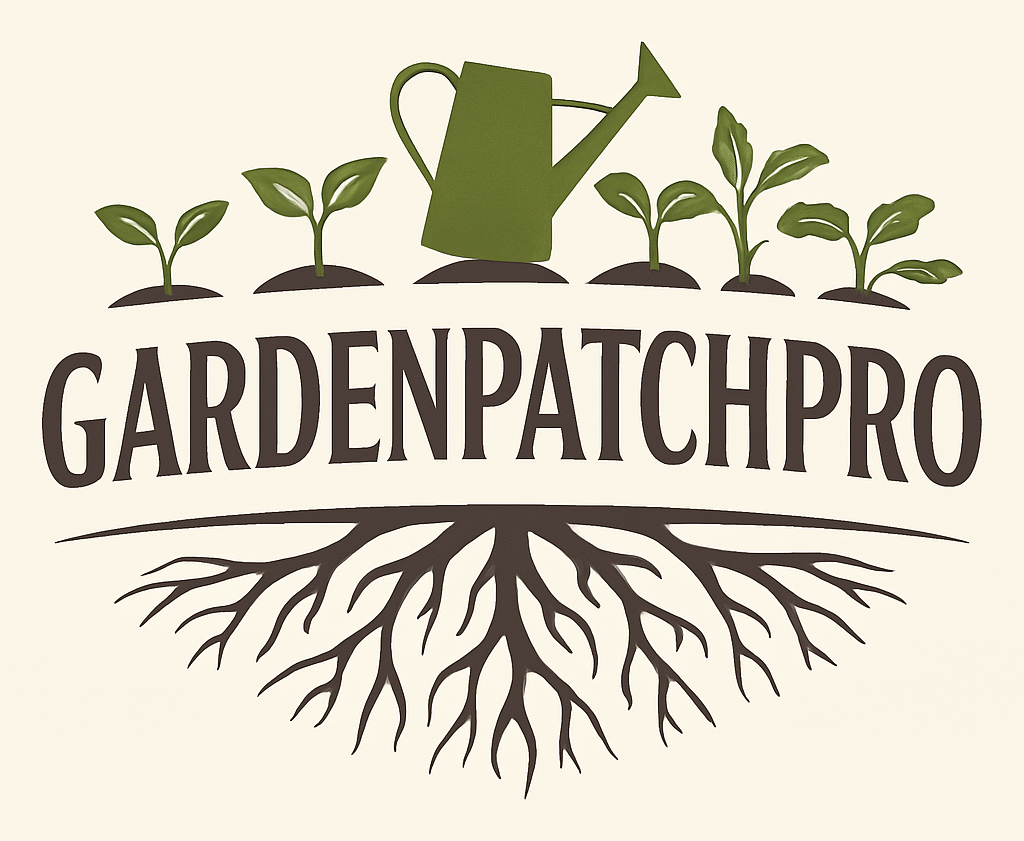19 Vegetable Garden Ideas: Creative Layouts & Planting Solutions
Growing a vegetable garden can be simple and rewarding with the right ideas tailored to your space and needs. Using methods like raised beds, containers, and vertical gardening helps maximize your growing area while making the process easier to manage. Thoughtful plant choices and pairing certain vegetables together also boost growth and keep pests away naturally.
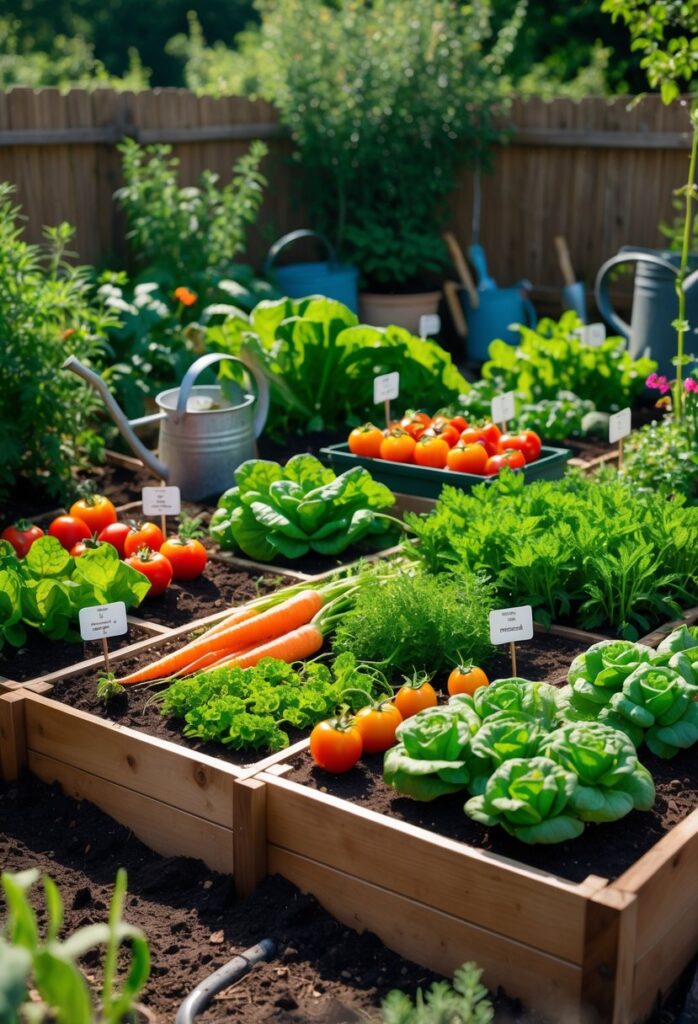
Whether you have a large backyard or a small balcony, there are practical ways to create a productive vegetable garden. With a good plan and some creativity, anyone can enjoy fresh, homegrown produce throughout the seasons.
Key Takeaways
- Smart garden setups improve space use and plant health.
- Choosing the right plants and combinations supports growth and pest control.
- Consistent care and design enhance productivity and enjoyment.
Essential Planning for Vegetable Gardens
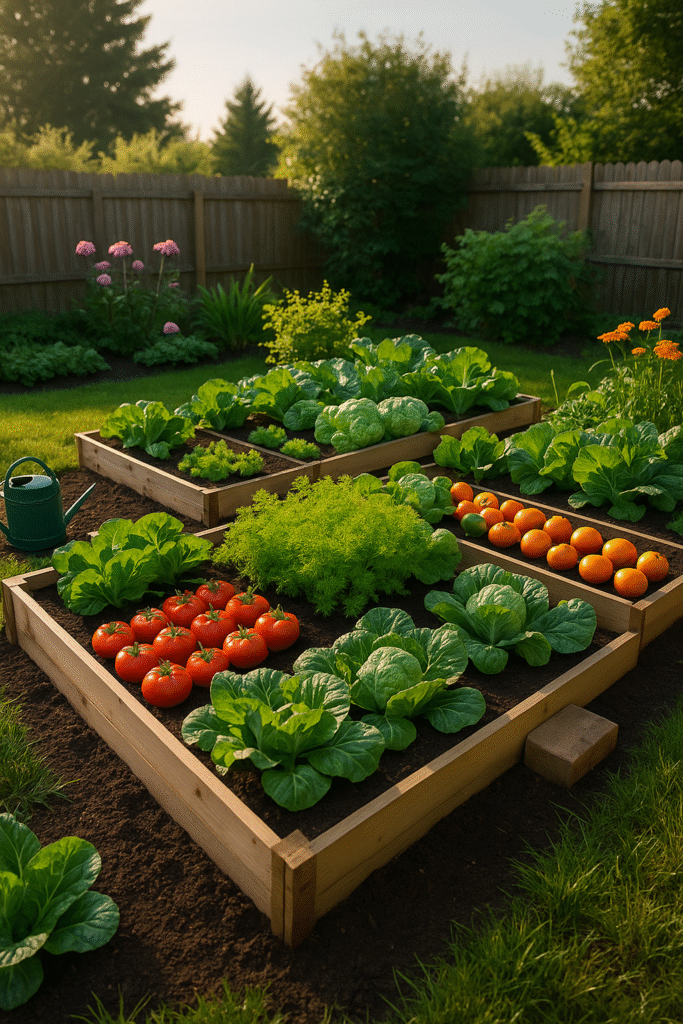
Successful vegetable gardens start with practical choices. Selecting an ideal spot, improving the soil, and picking the right garden layout all affect how well the plants grow. Each decision helps manage sunlight, moisture, and space efficiently to support healthy vegetables.
Choosing the Right Site and Sunlight
The garden site should receive at least 6 to 8 hours of direct sunlight daily. Most vegetables need full sun to produce well.
It’s best if the site has good air circulation to reduce disease risks. Avoid low spots where water may pool after rain.
Look for a flat or gently sloping area to prevent soil erosion and make watering easier. Access to a water source nearby is important for regular irrigation.
Make sure the location is away from large trees or buildings that cast shade. Reflective surfaces like light-colored walls can also increase light in smaller spaces.
Soil Preparation and Organic Matter
Healthy soil is critical for a productive vegetable garden. The soil should be loose, well-drained, and rich in nutrients.
Start by testing the soil pH. Most vegetables prefer a slightly acidic to neutral range (6.0 to 7.0).
Add organic matter such as compost, well-rotted manure, or leaf mold to improve soil texture and fertility. Organic matter helps retain moisture and promotes beneficial soil microbes.
Avoid compacted soil by turning it gently but not too deeply. This encourages root growth and better water absorption.
Regularly adding mulch on the surface helps keep moisture steady and limits weed growth.
Garden Layout Selection
Choosing a garden layout depends on available space, the types of vegetables, and gardening goals.
Raised beds offer better drainage and soil control. They can be designed precisely, making it easier to organize plants by type or growing season. Raised beds are ideal for small gardens or poor native soil.
Square foot gardening breaks the bed into small sections, maximizing space by carefully spacing each vegetable in one-foot squares.
Vertical gardening uses trellises or pallets to grow climbers like beans and cucumbers upward, saving ground space.
Multi-bed gardens separate plants to reduce pest problems and allow companion planting, which can improve growth and protect crops.
For detailed garden layout ideas, several guides offer plans tailored to different garden sizes and aims, helping gardeners pick the best option for their needs. These plans include spacing, plant types, and seasonal rotation to maximize yield.
For more ideas, see vegetable garden plans and layouts that fit small or large spaces.
Raised Beds and Container Solutions
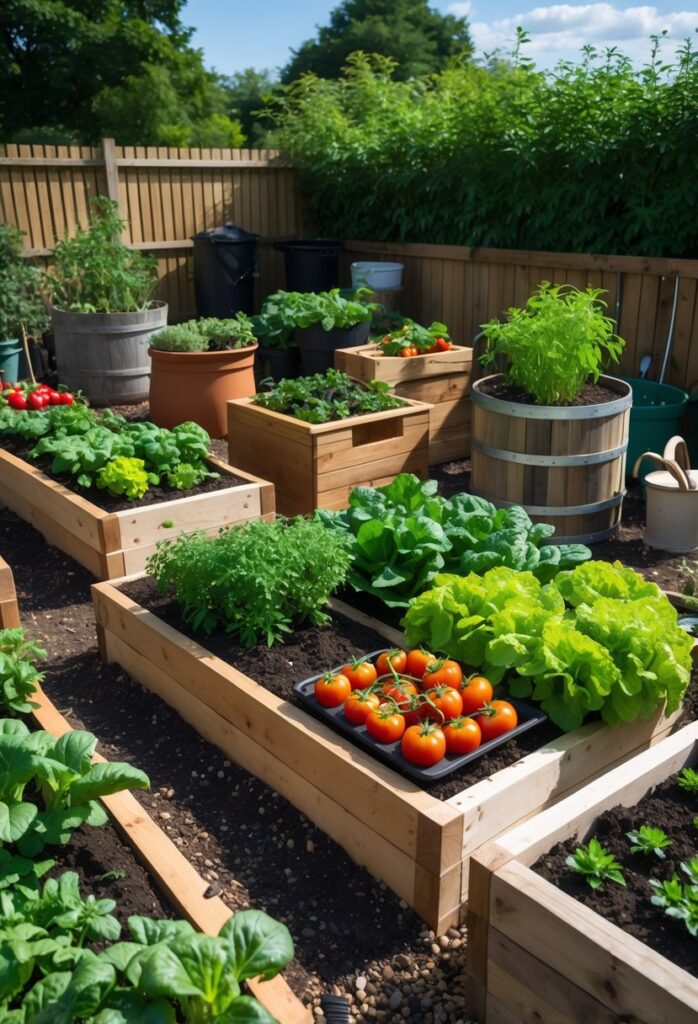
Raised beds and container gardens offer practical ways to grow vegetables efficiently. They let gardeners control soil quality, manage pests, and save space. Both methods can work well in small yards, patios, or spots with poor soil.
Benefits of Raised Beds
Raised beds lift the growing area above the ground, improving soil drainage and aeration. This helps prevent waterlogging, which can harm vegetable roots.
They make soil management easier. Gardeners can add compost or amend soil precisely to suit crops, creating ideal conditions for a potager or kitchen garden.
Raised beds reduce back strain by bringing plants to a comfortable height, which is good for gardeners with mobility issues.
They also help keep weeds and pests down since the contained space can be monitored and protected more easily.
Creative Raised Bed Designs
Raised beds come in many styles, from simple wooden frames to tiered, multi-level layouts. Using materials like wood, brick, or stone adds durability and aesthetic appeal.
Some raised gardens incorporate trellises for climbing vegetables like beans or cucumbers. Others are built in geometric shapes to maximize space and create attractive kitchen gardens.
Adding compost directly into raised beds improves soil fertility over time. Raised beds can also be arranged to optimize sunlight exposure for different plants.
For design inspiration, see popular ideas for building raised vegetable garden beds with clear step-by-step instructions.
Container Gardening for Small Spaces
Container gardening suits balconies, patios, and small yards where traditional beds won’t fit. Containers let gardeners control soil type completely and move plants as needed.
Raised containers can be filled with specially mixed soil and compost, providing a rich growing medium for vegetables.
Containers come in various sizes and materials such as plastic, clay, or wood. Vertical containers and grow towers maximize space by allowing plants to grow upward instead of outward.
This method is flexible and accessible, ideal for gardeners with limited mobility or those in urban areas wanting fresh produce. It also helps manage pests by isolating plants.
For practical container garden ideas, explore solutions perfect for small spaces to grow fresh vegetables efficiently.
Vertical and Space-Saving Gardening
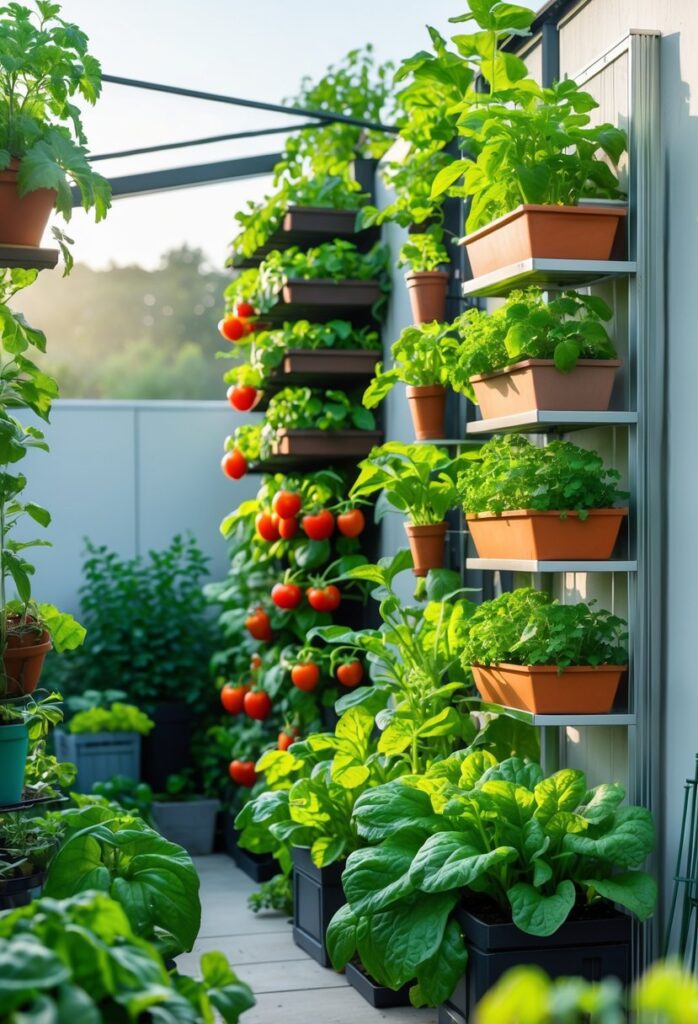
Maximizing garden space is key for many growers. Using vertical designs, hanging systems, and stacked planters allows gardeners to grow more plants in small areas. These methods boost yield without requiring extra ground space, making them perfect for urban or compact gardens.
Vertical Garden Structures
Vertical garden structures use frameworks like trellises, poles, and cages to support climbing vegetables such as tomatoes, cucumbers, and peas. These structures keep plants upright, improving air circulation and sunlight exposure.
They reduce disease risk by keeping leaves and fruit off the soil. Vertical setups also simplify harvesting and make it easier to manage plants.
Common materials include wood, metal, or plastic. Gardeners can build simple trellises or use ready-made vertical towers that maximize production in tight spaces. These sturdy frameworks help maximize garden layouts by organizing crops upward.
Ladder and Hanging Gardens
Ladder gardens use wooden or metal ladders as vertical supports for pots or planting boxes. Steps hold containers with herbs, leafy greens, or small vegetables, creating layers of growing space.
This design is easy to assemble and move if needed. It also adds a decorative touch while saving room.
Hanging gardens use baskets or pots suspended from ceilings, walls, or stands. They work well for herbs and lightweight plants, freeing up floor space.
Both ladder and hanging gardens provide access to sunlight at different heights, which benefits plant growth and garden aesthetics.
Stacked and Wall Planters
Stacked planters arrange pots or boxes in vertical tiers, often in a compact footprint. These can be made from wood, plastic, or recycled materials such as pallets or crates.
This method supports a variety of crops in one spot, allowing gardeners to mix plants with different root depths.
Wall planters attach directly to fences, walls, or other vertical surfaces. They hold small pots or pockets for herbs, greens, and compact vegetables.
Using a wall planter turns unused vertical surfaces into productive garden areas, ideal for balconies or narrow yards.
Both stacked and wall planters optimize growing space while keeping plants organized and accessible.
For more ideas and examples, see vertical garden tips at Plantisima.
Plant Selection and Companion Planting
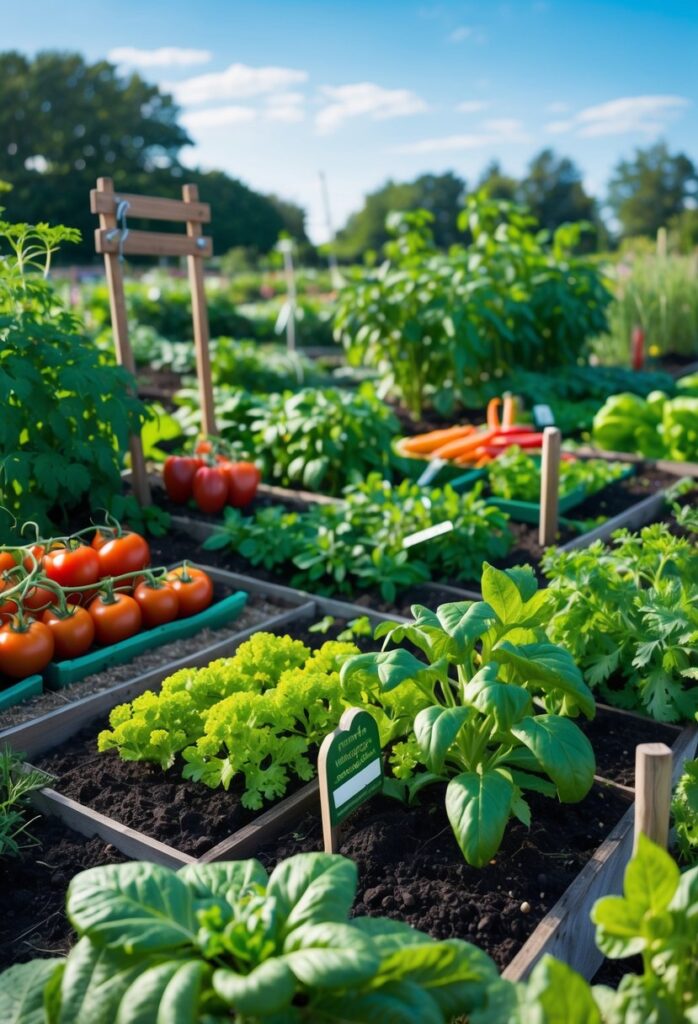
Choosing the right plants and arranging them carefully can make a vegetable garden more productive and healthier. It helps to select vegetables that fit the space and climate, include useful herbs, and use companion planting techniques to support growth and reduce pests.
Best Vegetables for Home Gardens
Vegetables like tomatoes, peppers, and cucumbers are popular because they produce well in most home gardens. Leafy greens such as lettuce and spinach grow quickly and can be harvested multiple times throughout the season.
Root crops like carrots and radishes are useful for patching small spots since they don’t need much surface space. Beans add value by fixing nitrogen in the soil, which helps other plants grow better.
When choosing plants, it’s important to consider maturity dates and how much sunlight the garden receives. Starting seeds indoors for tomatoes and peppers can give the season a head start, especially in cooler climates.
Popular Herbs and Edibles
Herbs like basil, chives, and parsley are easy to grow and good companions for many vegetables. Basil enhances tomato flavor and repels insects like mosquitoes. Chives and onions deter pests such as aphids and beetles.
Many gardeners include herbs to attract pollinators, such as bees and butterflies, which improve vegetable yields. Marigolds are also popular for their pest-repelling properties.
Planting herbs close to vegetables helps save space and makes harvesting convenient for kitchen use. They thrive in containers or mixed garden beds, supporting a balanced garden ecosystem.
Companion Planting Techniques
Companion planting involves placing certain plants near each other to help each grow better. For example, the “Three Sisters” technique uses corn stalks for beans to climb, beans fix nitrogen in the soil, and squash covers the ground to block weeds.
Other plant pairs work well too. Tomatoes and basil grow well together, while beans and carrots help each other thrive. Some plants, like nasturtiums, act as traps, attracting pests away from vegetables.
Using companion planting reduces pests and supports pollinators while improving soil health. Gardeners can plan their beds by combining plants with complementary needs and defensive traits for a strong, healthy garden.
For more details, see this Companion Planting Chart for Vegetables.
Integrated Flowers and Beneficial Insects
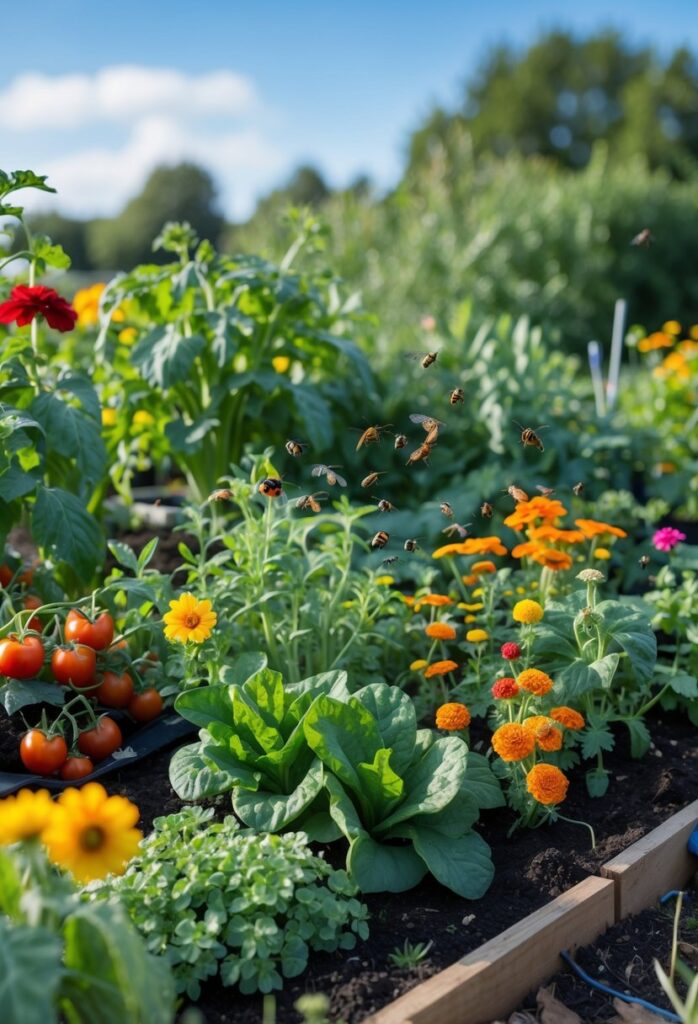
Flower plants can play a key role in vegetable gardens by helping control pests and supporting pollination. Carefully chosen flowers can attract helpful insects that protect crops and improve harvests. These flowers work well when combined with vegetables to create a balanced garden ecosystem.
Using Marigolds and Nasturtium
Marigolds and nasturtium are popular in vegetable gardens because they help repel harmful pests. Marigolds produce a scent that some insects dislike, which keeps pests like nematodes and aphids away from vegetables.
Nasturtium acts as a trap crop by attracting pests such as caterpillars and aphids, which then avoid damaging the main vegetable plants. Both flowers add color and can grow alongside tomatoes, beans, and lettuce without competing for nutrients.
Planting these flowers near vegetable beds creates a natural barrier that reduces the need for chemical pesticides while making the garden more attractive.
Encouraging Pollinators
Pollinators such as bees and butterflies are essential for many vegetables to produce fruit and seeds. Flowers like sunflowers, lavender, and daisies draw these pollinators by offering nectar and pollen.
By including these flowers, a garden can boost pollination rates, which often leads to larger, healthier crops. Pollinator-friendly flowers should be spaced throughout the garden to create easy access.
Providing a variety of blooms throughout the growing season supports a range of pollinator species, helping the garden thrive.
Mixing Flowers with Vegetables
Combining flowers with vegetables encourages beneficial insects that prey on pests and improve the garden’s health. This practice, called companion planting, helps reduce pest damage naturally.
For example, planting flowers that attract ladybugs or lacewings near vegetable beds promotes pest control. These beneficial insects feed on aphids, mites, and other harmful pests.
Mixing flowers like marigolds, nasturtium, and sunflowers with vegetables not only supports insect biodiversity but also enhances the visual appeal of the garden. This approach creates a sustainable balance for better vegetable growth and pest management.
More details on how flowers attract beneficial insects and protect vegetables can be found at combining vegetable and flower gardens.
Maintenance, Irrigation, and Pest Management
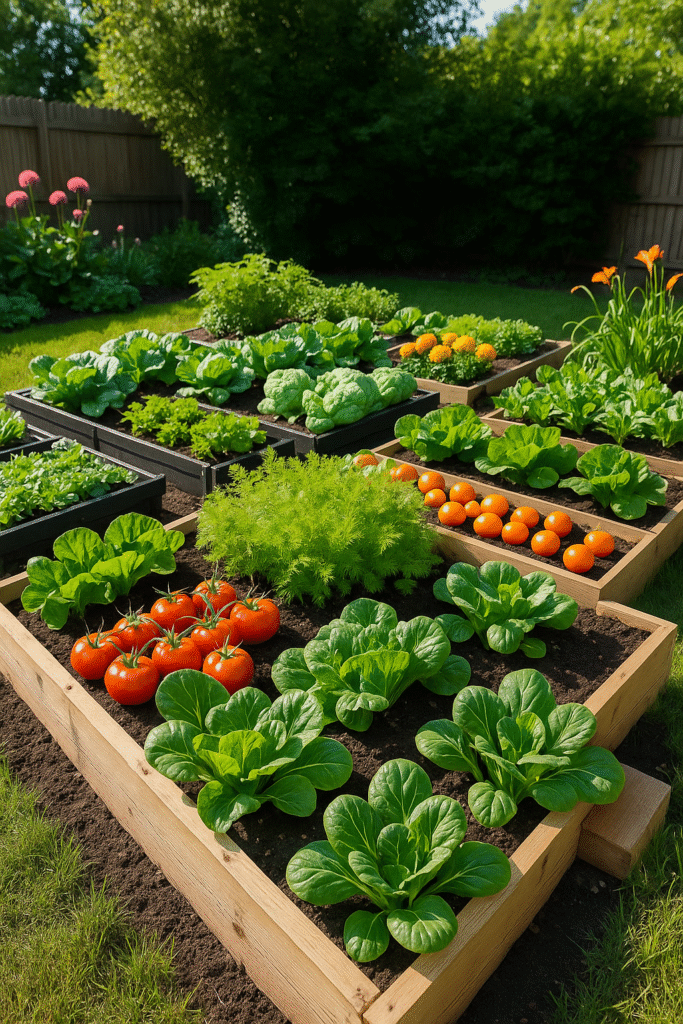
Proper care is needed to keep a vegetable garden healthy. Managing soil moisture, watering techniques, and pest control are all important to boost plant growth and prevent damage.
Mulching and Moisture Retention
Mulch helps keep soil moist by reducing evaporation. Adding about 2 inches of organic mulch like straw, wood chips, or leaves after planting cools the soil and retains water. It also controls weeds by blocking sunlight, which helps plants use nutrients better.
Mulching improves soil quality as it breaks down. This adds nutrients and encourages earthworms, which benefit plant roots. Applying mulch yearly supports steady moisture and reduces the need for frequent watering.
Mulch also protects against temperature swings by insulating soil during hot or cold weather. This creates a stable environment for roots, which helps plants grow stronger and resist stress.
Efficient Irrigation Systems
Efficient watering is key to healthy plants. Rather than watering leaves, targeting the roots helps avoid diseases. Soaker hoses or drip irrigation systems deliver water directly to the soil, reducing water waste and leaf moisture.
On average, gardens need about an inch of water weekly, but requirements vary by plant type. Regular, deep watering encourages roots to grow deeper, making plants more drought-resistant.
Automated irrigation timers can help maintain consistent watering schedules, especially during dry spells. Avoid overhead sprinklers that wet plant foliage and increase the risk of fungal diseases.
Dealing with Pests
Regular inspection helps catch pest problems early. Some insects damage plants, while beneficial insects like ladybugs and lacewings protect them by eating harmful pests.
Physical barriers such as row covers prevent pests from reaching plants. Handpicking pests and removing affected leaves can reduce infestations without chemicals.
If necessary, natural pesticides or insecticidal soaps can be used carefully to limit harm to beneficial insects. Crop rotation also prevents pest buildup by disrupting their life cycles.
Keeping the garden clean and free of debris removes hiding spots for pests and reduces disease risk. A healthy garden with good maintenance is less likely to suffer severe pest problems.
For more detailed vegetable garden care, see this guide on vegetable garden care and maintenance tips.
Creative Layouts and Design Inspirations
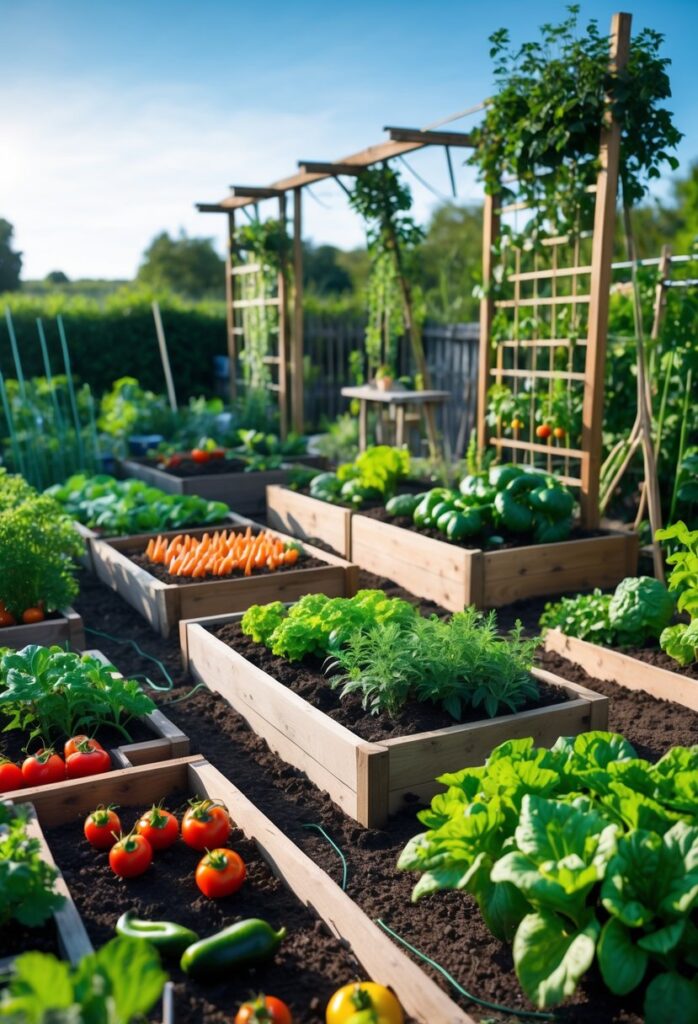
Effective garden layouts organize space efficiently and boost productivity. Different styles focus on maximizing growing areas, ease of maintenance, and visual appeal. The right design helps with plant growth, access, and garden flow.
Square-Foot Gardening Methods
Square-foot gardening breaks the plot into small, manageable sections, usually 1-foot squares. Each square grows a specific number or type of plants, based on their size and spacing needs. This method saves space and reduces weed growth.
Raised beds work well here, allowing better soil control and drainage. Gardeners can plan rotations easily and harvest quickly. It’s ideal for beginners or those with limited space since it simplifies planting and care.
The approach increases yields by making the best use of every square foot. Plants like lettuce, carrots, and radishes fit well. Tools and watering systems can be optimized for smaller, neat planting areas, ensuring efficiency.
Japanese and Modern Garden Ideas
Japanese garden design emphasizes balance, simplicity, and natural harmony. In vegetable gardens, this means integrating plants with decorative elements like stones and water. Paths and small bridges can guide access while creating a peaceful space.
Modern gardens focus on clean lines and functionality. Raised beds with geometric shapes, vertical growing walls, or container arrangements create a structured yet practical look. Materials like steel and concrete add modern texture.
Both styles stress accessibility and flow. They allow gardeners to grow vegetables attractively while encouraging calm and order in the space. Mixing traditional Japanese planting with modern elements can enhance both beauty and productivity.
Potager and Kitchen Garden Styles
The potager is a French-style kitchen garden combining vegetables, herbs, and flowers in a decorative way. Beds are often arranged in symmetrical patterns with clear paths. This layout blends usefulness with aesthetics.
Plants are chosen for both their harvest and appearance, such as colorful Swiss chard or flowering beans. Companion planting is common to improve growth and reduce pests.
Kitchen gardens prioritize easy access, usually near the home for convenience. Raised beds, borders, and trellises are placed for quick harvesting. The potager style supports a natural, productive, and visually pleasing vegetable garden layout.
For more ideas, explore creative vegetable garden designs with practical steps and examples at Gardening Gems.
Frequently Asked Questions
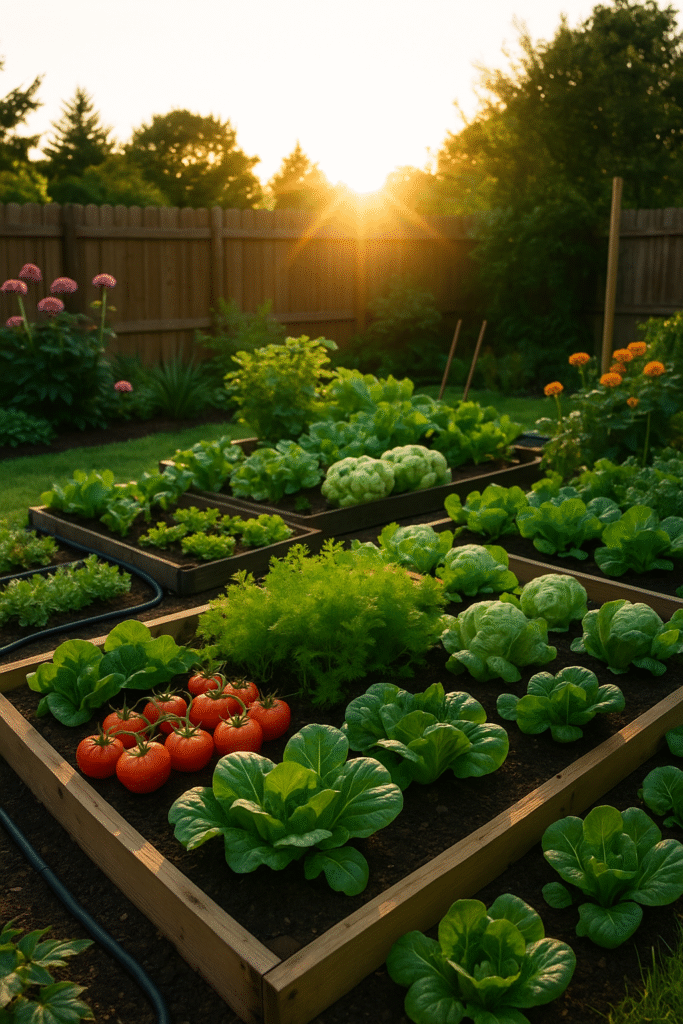
A well-planned vegetable garden uses space efficiently and combines beauty with purpose. Choosing easy vegetables, organizing beds clearly, and using helpful tools all make gardening smoother. Smart layouts and thoughtful plant choices improve both yield and appearance.
What are the most effective vegetable garden layout designs for small spaces?
Vertical gardening and stacked raised beds work well in small areas. Using tiered containers or wall-mounted planters maximizes growing space. Grouping plants with similar water and sunlight needs helps maintain a healthy garden.
How can I create a beautiful vegetable garden that is also functional?
Mix vegetables with flowers and herbs to add color and attract pollinators. Use tidy rows or raised beds to keep walkways clear. Adding elements like a small water feature or decorative containers can enhance the look without hurting productivity.
Is there a free planner app to help design my vegetable garden layout?
Several apps offer free versions for garden planning. These tools allow users to map garden beds, note plant spacing, and track planting dates. They help visualize the layout before planting, making adjustments easier.
Which vegetables are best suited for a beginner’s garden?
Lettuce, spinach, radishes, and bush beans are simple and quick to grow. These plants have forgiving growing conditions and don’t require extensive care. They provide early success and build confidence for new gardeners.
Can you provide tips for organizing a 20×40 foot vegetable garden efficiently?
Divide the space into beds or plots around 3 to 4 feet wide for easy access. Rotate crops yearly to reduce pests and soil depletion. Install trellises for vining plants like peas and cucumbers to save ground space.
What are the key considerations for planning an in-ground vegetable garden layout?
Soil quality and drainage must be assessed first. Group plants by sunlight needs and companion planting benefits. Leave enough spacing between plants for airflow to reduce disease risk and plan paths for easy maintenance.
For more ideas on vegetable garden layouts and tips, visit 19 Vegetable Garden Ideas for Any Size Yard.
